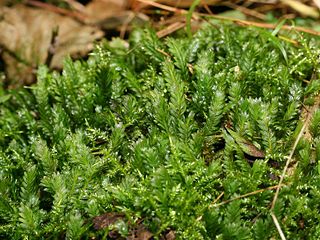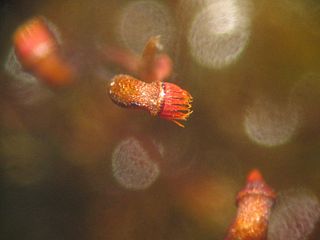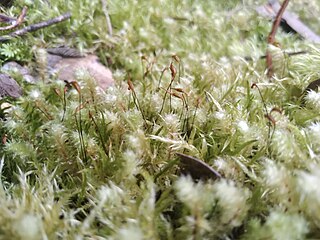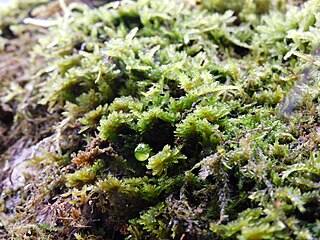
Fissidens adianthoides, the maidenhair pocketmoss, is a moss in the family Fissidentaceae. It was first collected by Hedwig in 1801.
Peristome is an anatomical feature that surrounds an opening to an organ or structure. Some plants, fungi, and shelled gastropods have peristomes.

The Bryopsida constitute the largest class of mosses, containing 95% of all moss species. It consists of approximately 11,500 species, common throughout the whole world.

Tetraphidaceae is a family of mosses. It includes only the two genera Tetraphis and Tetrodontium, each with two species. The defining feature of the family is the 4-toothed peristome.

Itatiella ulei is a species of moss in the family Polytrichaceae. It is the only species in the genus Itatiella. The Polytrichaceae is a common family of mosses that does not have close living relatives. Its small size and the inflexed leaf apex characterize Itatiella ulei. When this species grows directly exposed to sun at high elevations, it presents a similar aspect but can be distinguished based on the distal lamella cells which are single and rhombic.

Splachnaceae is a family of mosses, containing around 70 species in 6 genera. Around half of those species are entomophilous, using insects to disperse their spores, a characteristic found in no other seedless land plants.

Pogonatum urnigerum is a species of moss in the family Polytrichaceae, commonly called urn haircap. The name comes from "urna" meaning "urn" and "gerere" meaning "to bear" which is believed to be a reference made towards the plant's wide-mouthed capsule. It can be found on gravelly banks or similar habitats and can be identified by the blue tinge to the overall green colour. The stem of this moss is wine red and it has rhizoids that keep the moss anchored to substrates. It is an acrocarpous moss that grows vertically with an archegonium borne at the top of each fertilized female gametophyte shoot which develops an erect sporophyte.

Climacium dendroides, also known as tree climacium moss, belongs in the order Hypnales and family Climaciaceae, in class Bryopsida and subclass Bryidae. It is identified as a "tree moss" due to its distinctive morphological features, and has four species identified across the Northern Hemisphere. The species name "dendroides" describes the tree-like morphology of the plant, and its genus name came from the structure of the perforations of peristome teeth. This plant was identified by Weber and Mohr in 1804. They often have stems that are around 2-10 cm tall and growing in the form of patches, looking like small palm-trees. They have yellow-green branches at the tip of stems. The leaves are around 2.5-3 mm long, with rounder stem leaves and pointier branch leaves. Their sporophytes are only abundant in late winter and early spring, and appears as a red-brown shoot with long stalk and cylindrical capsules.
Isobryales are an order of moss. Its taxonomic status is not clear. The Integrated Taxonomic Information System and National Center for Biotechnology Information databases consider it as a synonym of Bryidae and Hypnales, respectively. The Global Biodiversity Information Facility considers it valid in its own right.

Ptychominon aciculare is a species of moss found predominantly in Australia, New Zealand, New Caledonia, Samoa, Juan Fernandez Islands and Chile. It is easily recognised given its similarity, especially when partially dried, to a pipe-cleaner. This name is commonly accepted across Australia and New Zealand. It has been observed growing from between sea level to sub-alpine altitudes (1200m).

Fissidens limbatus commonly known as Herzog's pocket-moss, is a moss in the family Fissidentaceae. This species is found growing in high elevations in tropical America in addition to the US, Mexico and Canada. Montagne first collected F. crispus in 1838.

Plagiomnium venustum, also known as magnificent leafy moss, is a species of moss belonging to the family Mniaceae. It is found mainly in western North America along the coastal region. This moss can be identified from other members of the Plagiomnium genus by dark coloured stomata guide cells and the absence of sterile stems. It is most commonly found growing as a mat on a variety of substrate, but mainly on humus and moist soil.

Orthotrichum lyellii, also known as Lyell's bristle moss, is a species of acrocarpous moss belonging to the family Orthotrichaceae. O. lyellii can be found throughout western North America and Europe. It is found most commonly growing epiphytically on a variety of trees, and less commonly on rocks or boulder substrates.

Rhynchostegium is a genus of pleurocarpous mosses belonging to the family Brachytheciaceae. The genus has a cosmopolitan distribution across different climatological regions except the polar regions, mostly in tropic to north temperate regions. The genus contains both aquatic and terrestrial species. The genus was named for their rostrate opercula. The type species of this genus is Rhynchostegium confertum (Dicks.) Schimp.

Syntrichia latifolia, formerly Tortula latifolia, and commonly known as water screw-moss, is a species of moss belonging to the family Pottiaceae. Syntrichia species differ from members of Tortula due to synapomorphic leaf qualities, such as different basal and distal cells, as well as different costal cross sections where Tortula has an abaxial epidermis and Syntrichia lacks one.

Polytrichastrum formosum, commonly known as the bank haircap moss, is a species of moss belonging to the family Polytrichaceae.
Hypnum is a genus of mosses belonging to the family Hypnaceae.
Andreaea blyttii, also commonly known as Blytt's rock moss, is a moss belonging to the family Andreaeaceae, commonly known as rock moss, granite moss, or lantern moss because of this family's unique sporangium. It is part of the genus Andreaea which is known for forming dark brownish or reddish-black carpets in high elevations. This species was first described by Schimper in 1855.

Leptodontaceae is a family of mosses belonging to the order Hypnales. There are 3 genera with a worldwide distribution.

Wijkia extenuata, commonly known as spear moss or spiky wiki, is a species of moss from the family Pylaisiadelphaceae. It can be divided into two varieties Wijkia extenuata '-var. caudata and Wijkia extenuata var. extenuata. It is commonly found throughout the tropical, subtropical, and temperate forests of eastern Australasia and New Zealand.















